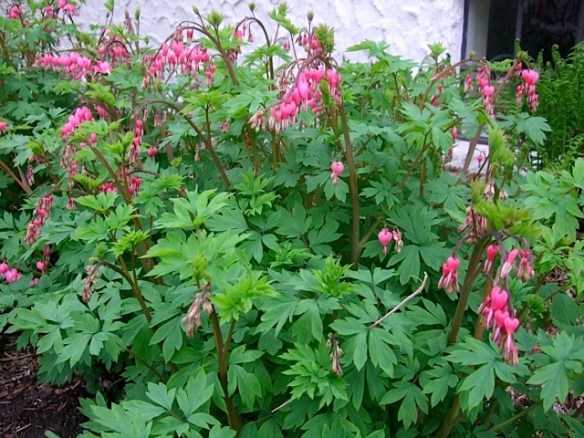One of the most versatile shade perennials that have beautiful and interesting leaves is Coral Bells. It is sometimes known as Alum Root or by the Latin name of Heuchera.
As a shade gardener I have learned that it isn’t just the flowers that are important to the garden. The structure and shape of the plant, as well as the shape and color of the leaves play a very important role in plant selection. Coral Bells mounding form make them great plants for edging bed lines, as ground covers, or for use in camouflaging height transitions such as a concrete step.
These plants grow best in light or partial shade. If Coral Bells are planted in too sunny a spot, the foliage bleaches out. If they are in too much shade, the plants become leggy. They also prefer neutral to alkaline soil that is well-drained with good air circulation.
These preferred growing conditions make it a perfect plant for my yard that is in transition to shade. I also know my soil runs alkaline – probably due to residual stucco construction materials left in the dirt.
Coral Bells have a strange habit of pushing themselves out of the dirt so it is good to mulch these plants especially in the fall so as not to sustain winter damage. In early January when we get rid of our Christmas tree, I cut the branches and loosely cover the Coral Bells as well to serve as further protection for this pretty plant.
Also after a few years you can divide the side clumps and plant them other places or give them away as friendship plants. This best done in spring and fall.
I started out with ‘Palace Purple’. It has fairly large leaves and is a brownish-purple color that blends in with the mulch. But quite frankly, I think there are so many prettier varieties. I have ‘Pewter Veil’ (2nd photo) by my front door softening the transition of the stoop.
I like the chartreuse leaves with dark red veining ‘Electra’ and I planted them near my chartreuse ‘Sum and Substance’ hosta along with dark burgundy leafed Coral Bells. Honestly I don’t know that variety. (I really am getting better about keeping records of my plants, but I got these a few years ago. I think just having a container in your garage as a place to put the tags is a good thing to do. Then if or when you want to, you can record your plantings in a journal but at least you have a place to put the tags when you are dirty and out planting).
Last fall I was the very lucky recipient of “Peppermint Spice” Heuchera from my very accomplished gardening friend Natalie. See the beauty of the leaves and the wiry flowers poking above the leaves (top photo). I use these wiry flowers in bouquets throughout the growing season. They just bring a bit of unexpected interest to a flower arrangement.
Have fun with these plants – plant different colors next to one another. Or pair them with plants that have different shapes such as ferns or frilly astillbes. Let me know what your favorites are.












